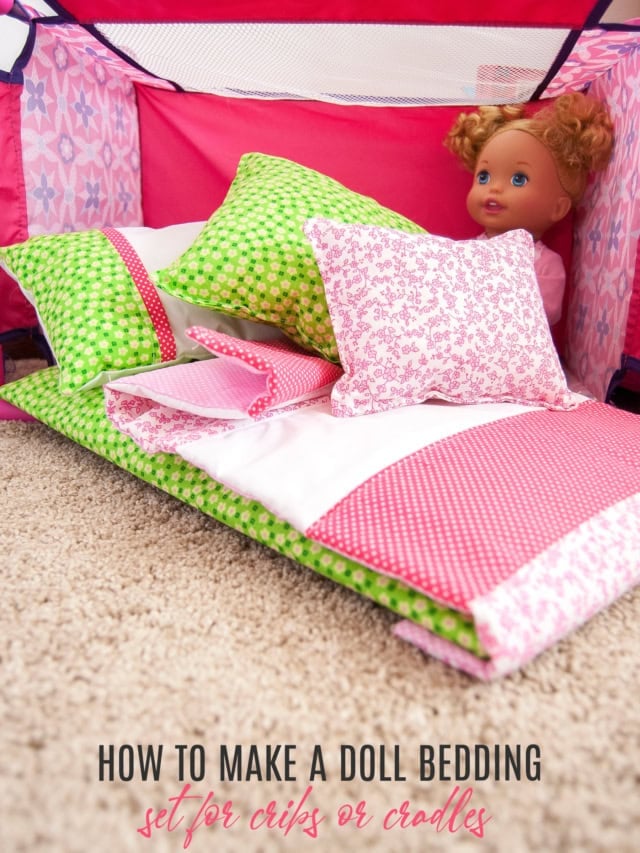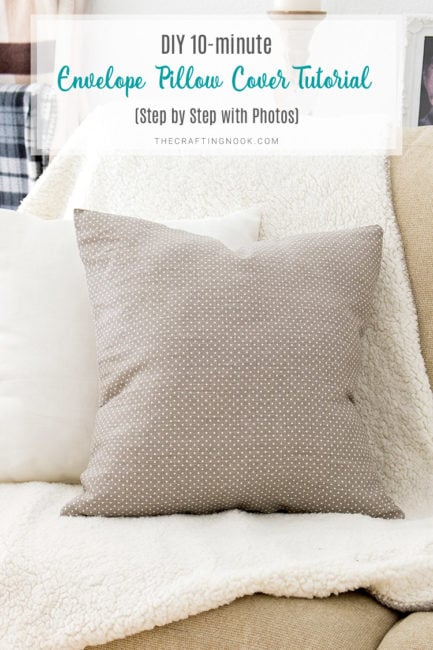DIY Sofa Slipcover. Update, Refresh, Renew
A new sofa is expensive, premade slipcovers do not always fit so if you are crafty and have a sewing machine at home, this DIY Sofa slipcover is the best option to have a brand new-looking sofa on a budget.
I can’t believe it I finally did it!!! I’ve been wanting to do this for years! I finally finished a slipcover for my sofa and my living room looks amazing now!
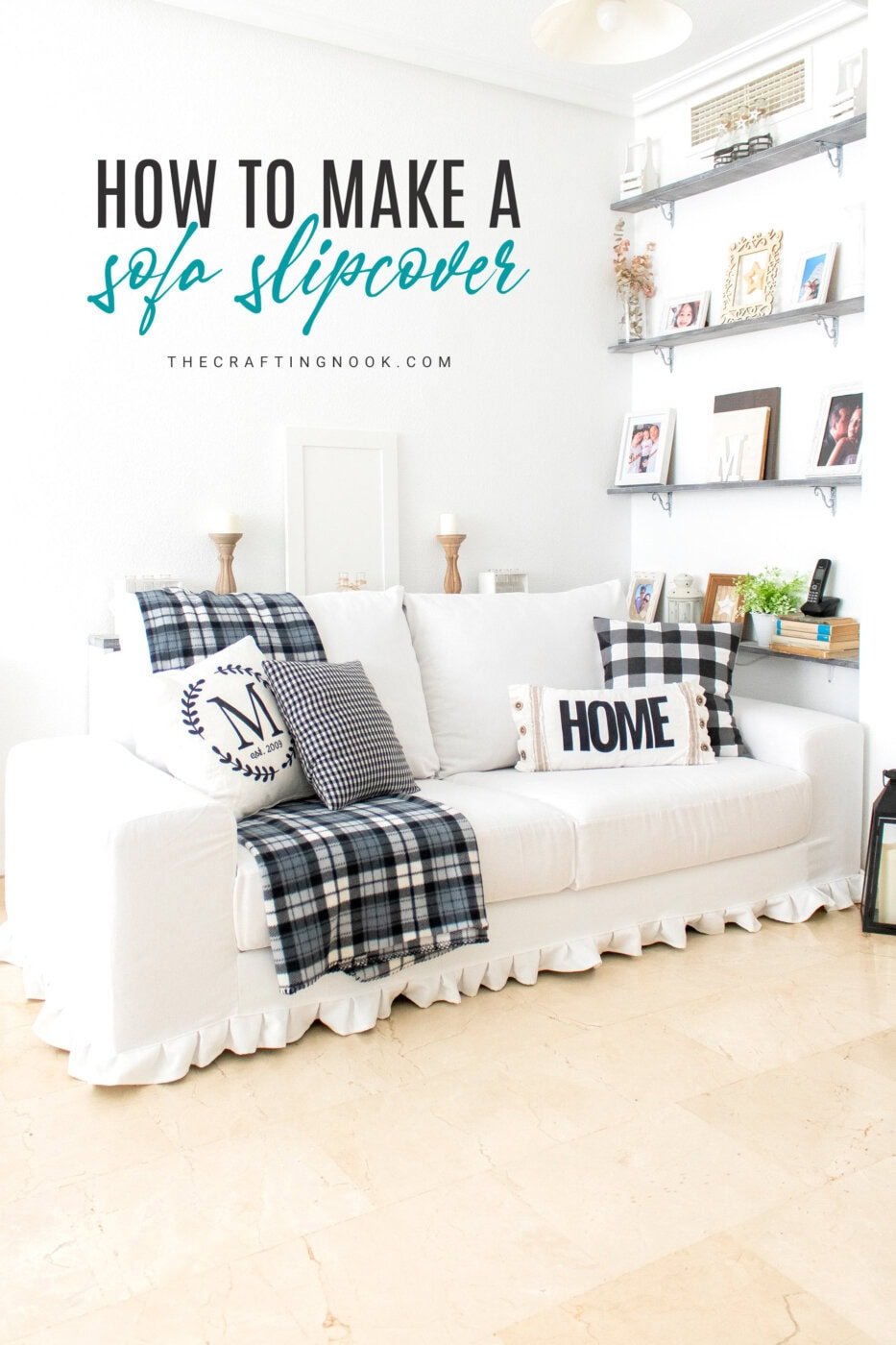
Table of Contents
Sofa Custom Slipcover Tutorial
The whole process took me about 2 weeks to complete because I couldn’t just invest all my time in it but the truth is it was not as hard as I thought it was going to be.
This post may contain affiliate links. Please read our Disclosure Policy.
Please bare with me here as I go through the process. This DIY couch slipcover is by far the hardest post I’ve had to write considering the complex nature of the project and the fact that English is not my first language. I’ll do my best to explain each step the best I can.
A few notes about Making my own Slipcover
My new cover was made with white canvas, I have been dying to have a white sofa since I can remember.
I’ve always been completely aware that having a white sofa requires more maintenance as it will be likely to get dirt and stains but I was willing to accept the consequences LOL.
My sofa is a second-hand piece of furniture that I got at a very good price. From the moment I saw it I knew it had the potential and the simplicity that would help me pull this off.
Gladly, I wasn’t wrong.

Want to learn how to make a sofa slipcover? Let me share with you the process.
But first, let me give you some context.
I’m not a professional sewer, I just have decent sewing skills. I manage to sew things here and there mostly for the home and sometimes for my girl to play with.
The way Ikea’s Ektop sofa inspired the way I approached my sofa: the main frame and each cushion have its own cover.
I didn’t want to just create a normal cover that you just lay on top of the sofa. Every time someone sits on it, it messes all up and I’m a control freak.
Replicating each cushion cover it already had and create a new sofa slipcover was the only option I could come up with.

When I was about halfway through the process, I discovered Megan’s slipcover tutorial from Two Feet First. Her strategy confirmed I was not that far from the right path.
I also discovered the right name for this project was “Slipcover” I thought it was plain upholstering LOL. Anyway I learned a few great tips from her.
The sofa is mostly geometric which made it easy to replicate the needed pieces to create a pattern.
I actually learned on the go so please bear with me as I go. Sadly, my camera stopped recording at some point and I didn’t notice, UGH! I couldn’t film the whole process as I was planning to.
I still put together a video explaining as much as I could though, giving tips and tricks along the process.
So, this is not a regular step-by-step tutorial per sei because each sofa is different. So as I create my slipcover, I explain what you need to pay attention to how to measure each piece and how to deal with different obstacles along the process.
How to Make A Sofa Slipcover
Supplies:
- Canvas Fabric (drop cloths work too but read that canvas is more durable)
- Felt (for anti-slip)
- Thread
- Upholstery Zipper (for the cushions)
- Velcro
- Fabric Marker
TOOLS:
- Sewing Machine
- Scissors
- Pins
- Measurement tape
- Ruler
Instructions:
I created this quick video tutorial to make it easy for you! However, if you are more of a photo step-by-step kind of person just scroll down and keep reading for detailed instructions!
Before we begin, be sure to follow us on Pinterest, Facebook, Instagram, and YouTube, and also sign up for our email list (at the end of this post), so you’ll never miss a post!
Step 1: Prep Work
First, don’t make the mistake I made, and wash your fabric before starting. I completely forgot. With all the excitement and planning the video the measurements and all, I forgot to wash the fabric. Luckily, it didn’t shrink after I washed the covers, but it could have LOL.
I love the way Christy from Confessions of Serial DIYer washes, dries and organizes the fabric again.
Getting measurements right was my biggest concern when I started this project. So, I definitely suggest measuring your sofa’s pieces really carefully and piece by piece. Sometimes it turns out that the front side might be larger or taller than the back side like it’s the case of my sofa’s seating cushions.
So, let’s take a look at my sofa, this is how it used to be (actually it still is but underneath the new covers LOL).

When you pull the cushions, you see that both, the seating and back cushions are attached together with a zipper.

I found it so clever that I decided to do the same on the new covers.
The seat cushion is a lot less fluffy and straightened so it was easier to measure each piece with the cover on.
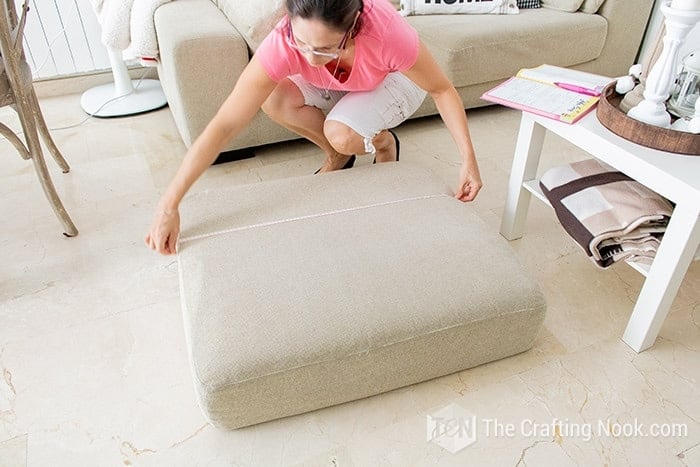
The Back cushion was easier measuring the cover alone straightened on the table.
Then the sofa had an anti-slip fabric that prevents the cushions from moving towards the front of the sofa.
I decided to keep that but using felt. It did the trick!
Step 2: Sofa Measurements
The first step in creating a custom cushion cover is to use your measuring tape to measure the cushion length, width, and height: I measured well top, bottom, and each side independently.
I took notes of each measure and then double-checked (call me paranoid)

Add about 2 cm (1/2″) to each measurement. This will allow for a 1 cm (1/4″) seam allowance on all sides and create a nice snug cushion cover.
I used the original cushion as a guide for where my zipper should start and end.
Then with the frame, I did the same. I measured each piece separately.

Step 3: Create your cushion plan
The next thing I did was create rough graphics of each piece with measurements to have a better idea of the piece I have to create.

It’s easier to have them on paper than having the huge cushions on the table LOL.
I didn’t want to do it like I saw most people doing it. Like throwing the fabric on top of the main frame of the sofa and then giving shape and securing with pins although it worked for them.
I thought that because this sofa was geometric enough for me to create the pattern based on measurements and I’m glad I did because it worked perfectly.
Step 4: Creating the Main Frame pattern
The pattern for my sofa’s main frame looks something like this:

Since the sofa arms’ corners are rounded, to get the exact curve I drew its shape on a piece of paper.
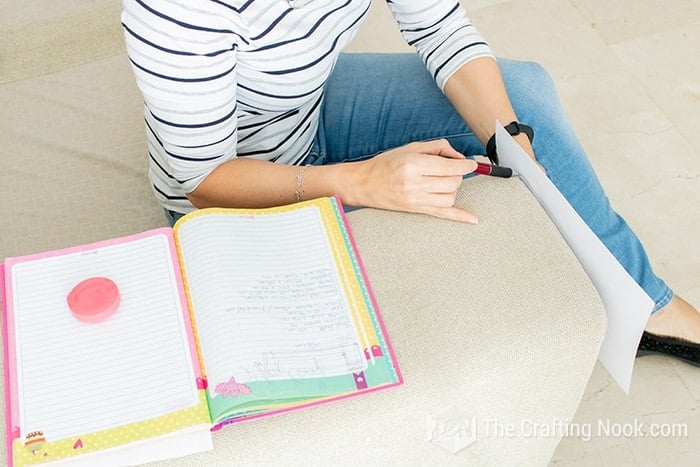
Then I folded the paper and cut so both curves would be exactly the same.
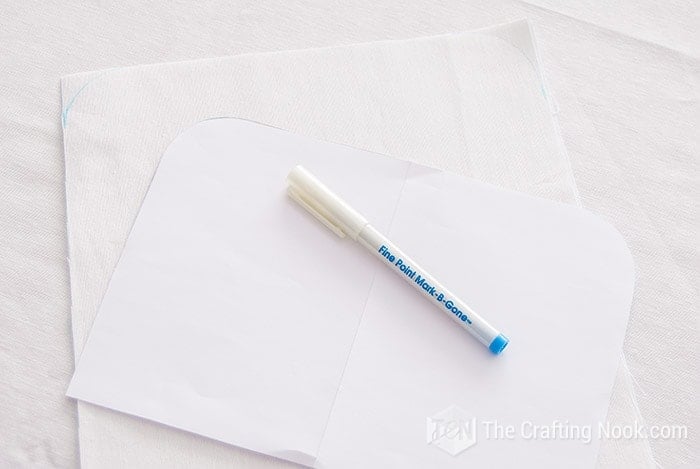
Step 5: Creating The Sofa Cushion Patterns
So, I started with the cushions. Gladly, since I have 2 sets, I experimented with one before actually recording and taking pictures to make sure it worked.
I’m glad I did because I found out the hard way that the front side of the seating cushion was taller than the back UGH. Thankfully I could fix it instead of making it all over again and wasting fabric.
So the pattern of my cushions looks something like this:


So, you will need to cut five pieces for each cushion: a top, a bottom, a piece for the back side where the zipper goes, a piece for the rest of the band around the middle AND a piece for the anti-slip piece (this last one is optional so I didn’t put it in the graphic).
*I didn’t add the cushion’s attachment in the graphics above either since are optional as well, but I’m explaining how to add it in case you like the idea.
I decided to make the front and both sides, one piece to make it look prettier but you can go for the separate pieces and sew them together if you prefer.
Optimizing the fabric (or any material for that matter) as much as I can is one of my top goals in this kind of project. so with the fabric folded (as it comes from the store) I measured the width, and based on that I calculated what pieces I could fit to I would waste the least.
It looked something like this:
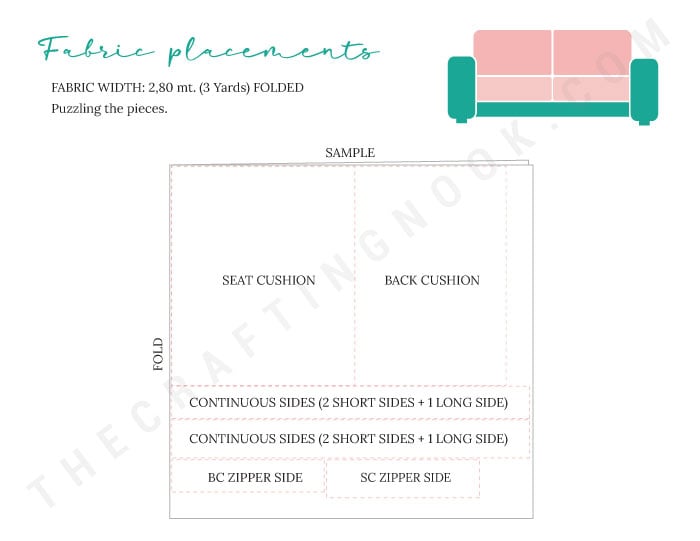
Step 6: Building the Back Cushion
I took my back cushion pieces and got the back and the felt pieces.
Fold them both widthwise and made a mark at the edge of the folding. This is to match centers.
Pin both places together with top edges aligned.
Stitch around the felt.
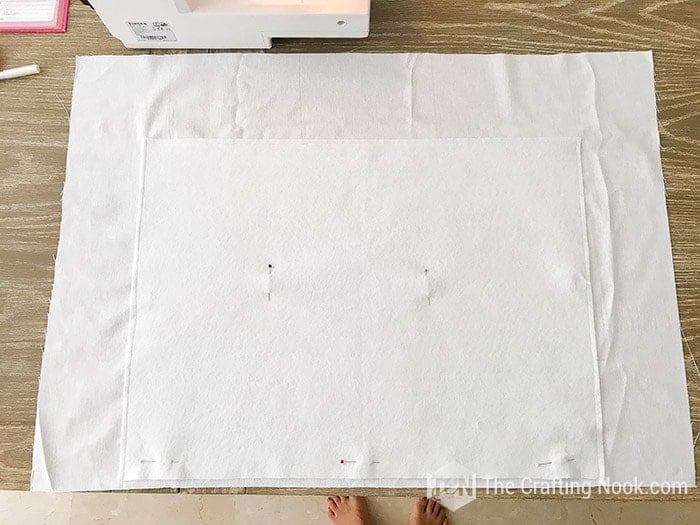
Then if like me, you are making white covers, you will inevitably wash them a lot.
Adding a zipper will make your cushion covers so much easier to remove and put back on. And adding a zipper really is easier than you think!
I used cut-to-size upholstery zippers. You can find them in package and depending on where you live you might be able to buy them by yards, so I was able to get zippers for for all 4 cushions.
I also bought 2 jacket-kind zippers because you can detach them. This will be for the cushion’s attachment. This step is totally optional. I found it very useful so went through the trouble of putting it.
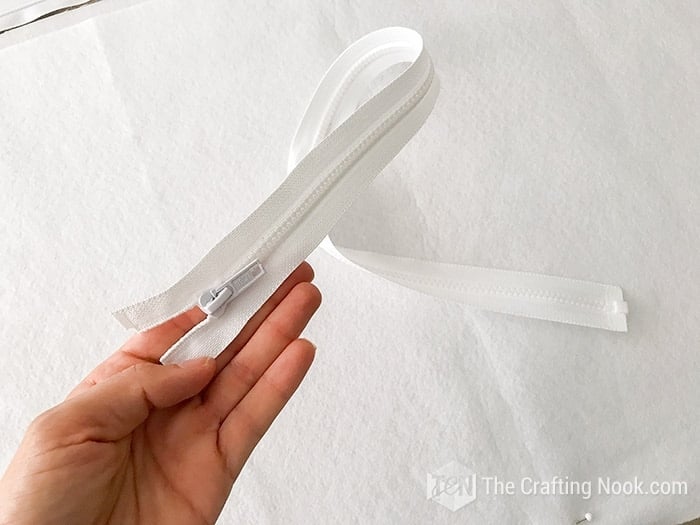
Since I used the original cushion as a guide for where my zipper should start and end, I cut the zippers the exact size as the original covers zippers.


I folded one edge over of the the bottom piece and the back piece of the cushion and pinned to the zipper. It helps to iron the first small fold first.

Since the zipper is shorter than the cushion I made sure it was centered making center marks as I did with the felt.
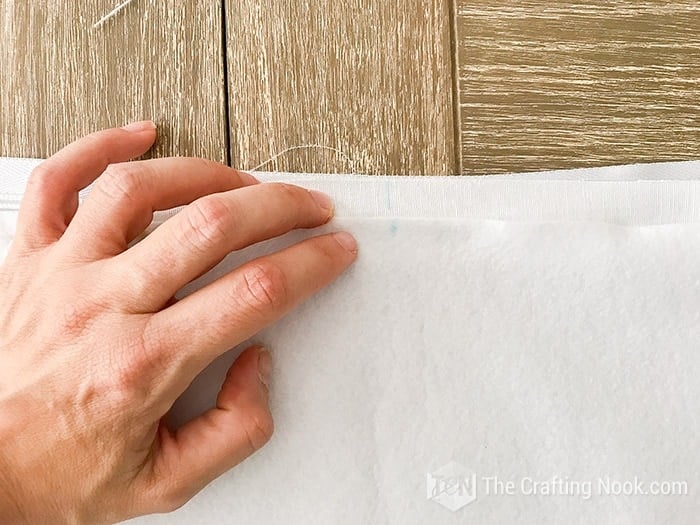
To add the attachment zipper like the original, I placed one of the pieces of the jacket zipper on top of the other zipper as centered as possible and slightly overlapping it. I used center marks as well.

So, it goes layered like this: Main zipper, jacket zipper, then back side piece of fabric (edge folded).
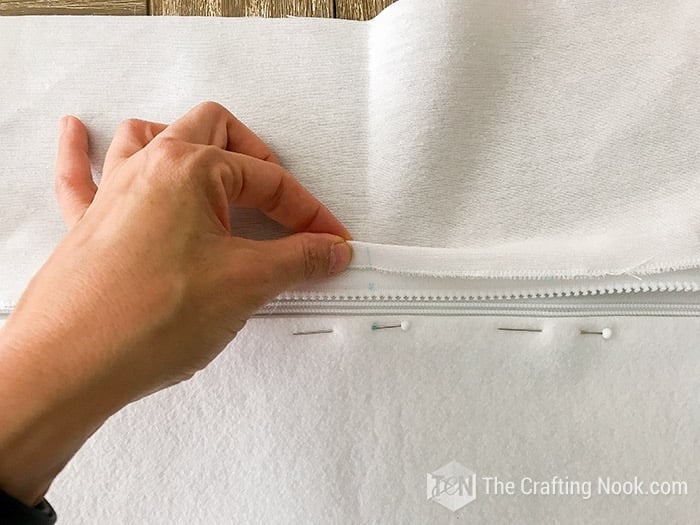
Pinned everything in place.
You should get something like this:
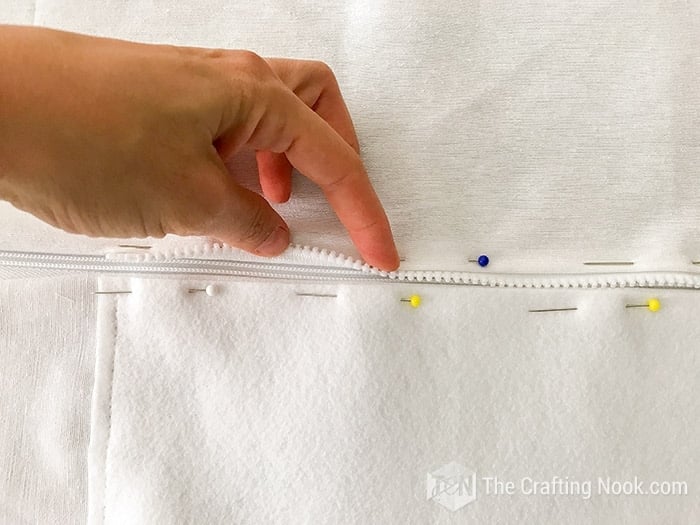
Then I sewed the fabric to the zipper using my zipper foot.
Honestly, I didn’t see the need to try to hide the zipper since it will be at the back, and it’s not gonna be visible.
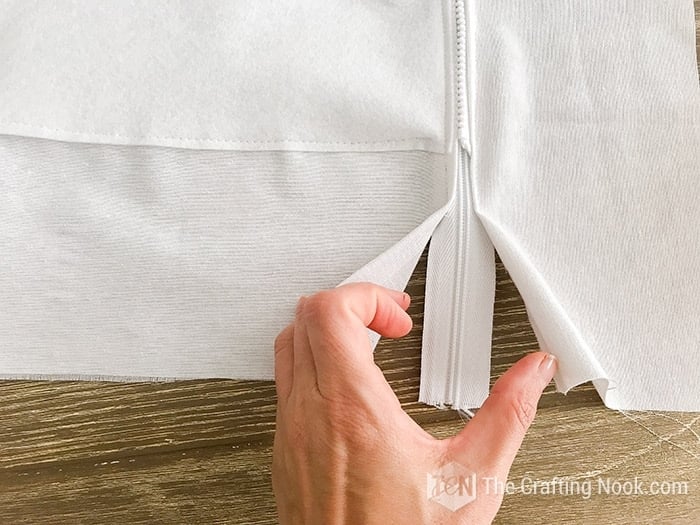
Since the zipper is shorter than the cushion’s width, I stitched the bottom piece and the side together as close as the sipper as possible until the end of the piece.
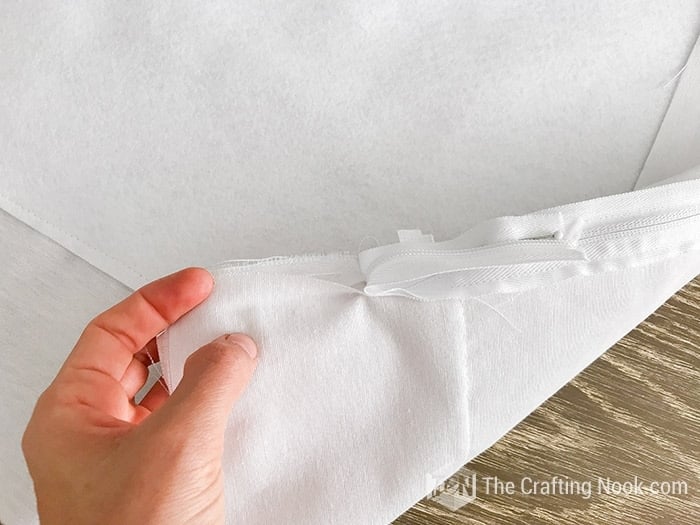
There you go, the zipper is installed.
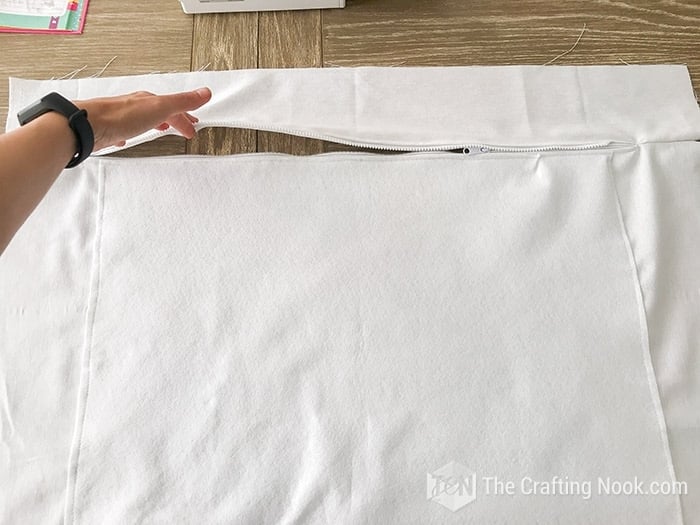
Then I pinned the bottom piece with the zipper to the rest of the band (right sides together) that will go around the center.
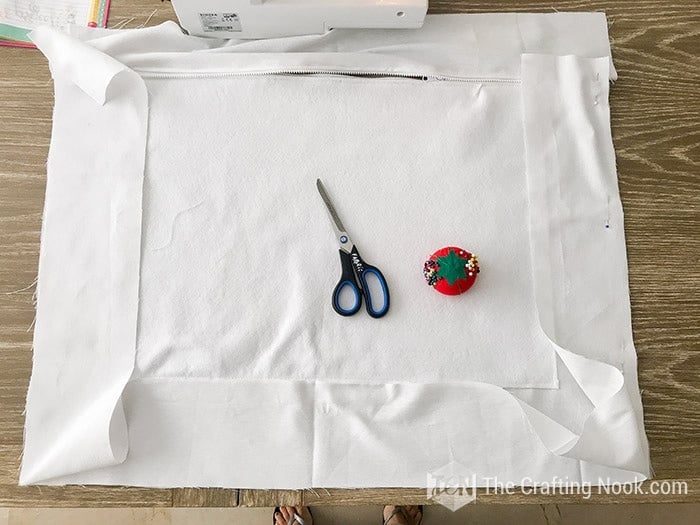
Next, I pinned the back piece with the zipper to both ends of the band.

I sewed the pieces together.
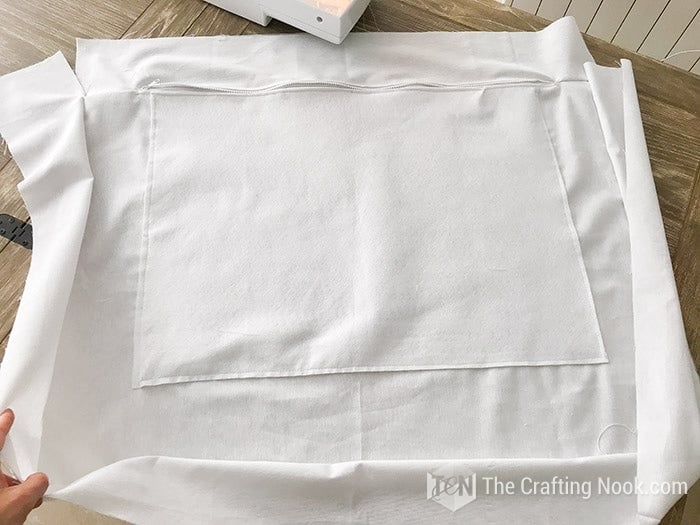
The last step for this cushion was the top piece.

I opened the zipper slightly so I could turn it inside out later and pinned the top piece to the back side and the side band. If all the measurements were ok, it should fit perfectly. And it did.

Sewed the pieces together and turned them inside out.
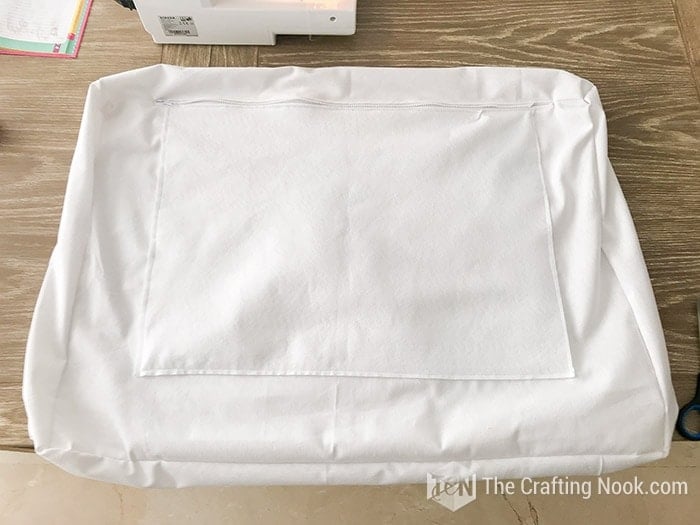
Voila!
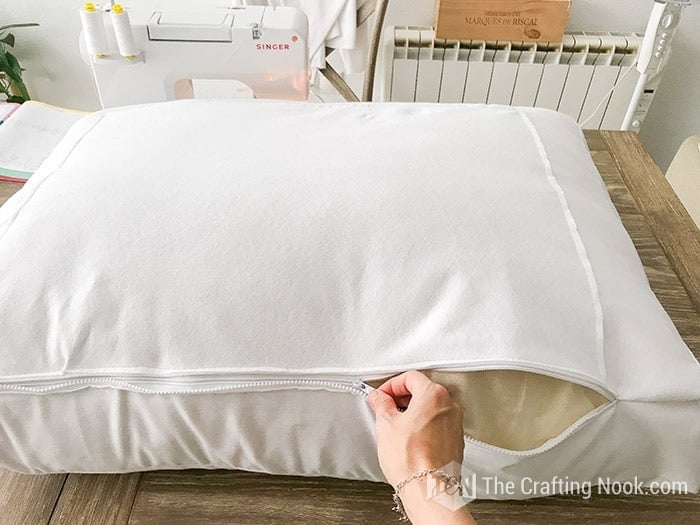
The cushion cover was ready to go!

Once I confirmed everything fit perfectly I went for the finishes. I zig-zagged all the raw edges.
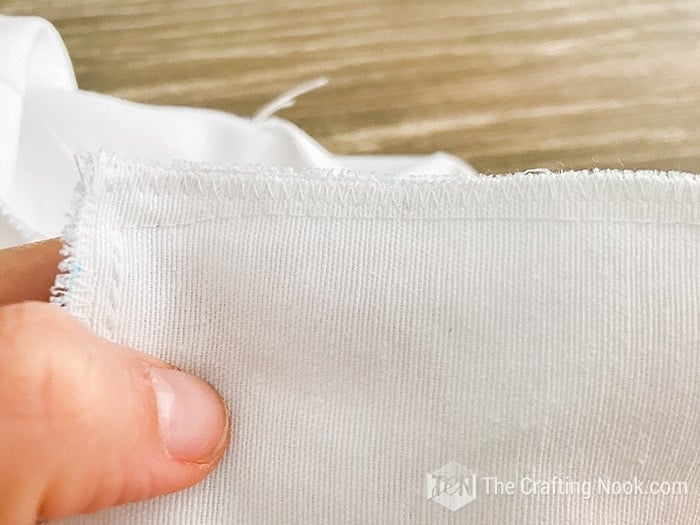
And then sewed over that seam very close to the edge on the right side of the cover to reinforce and create a prettier finish.

That was it.
Step 7: Building seat cushion.
The system was basically the same as the back cushion. The only difference was adding the attachment strip of fabric with zipper and the main zipper would go along to the sides of the cushion.
You can either do it as I did or modify the back piece following Christy’s Cushion tutorial which is great. In my case, I replicated the original cushion to the minimum detail LOL.
To create the attachment piece, I worked next to the original cushion to make sure I would install the zipper in the right place in the right position.

Making center marks, the attachment piece could be positioned exactly as it was on the original cushion

I zig-zagged the edges, then folded the fabric edge that goes on the zipper and stitched the zipper and hem on both short sides.
Next, I pinned the zipper in place. In this case back side and the attachment piece, both need to be right side up.
Pinned in place and tested that the back cushion would indeed attach perfectly. Stitched in place.
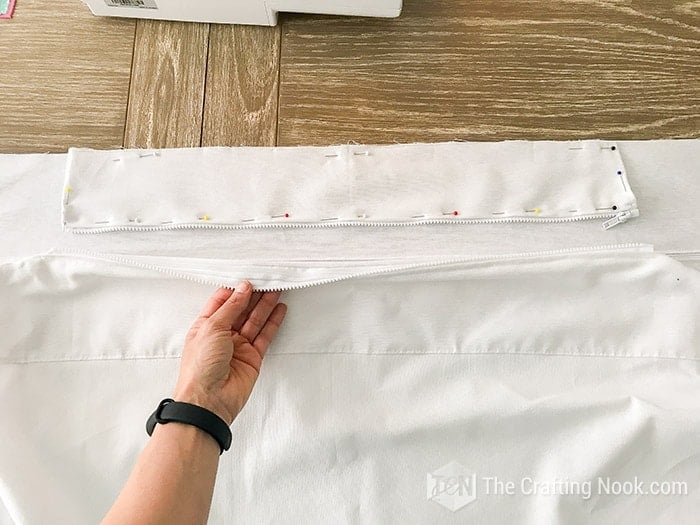
Then I followed the same steps from the back cushion.

To install the Zipper I just pinned the zipper as before but this time I followed the curve to on both corners to the sides and stitched. Here again, I didn’t bother to hide the zipper because it will not be visible.


The rest follows the exact same steps as the back cushion.
Of course, I repeated the process with the other set of cushions. When done they would look something like this:

Look how clever the attachments are!

Step 8: The main frame slipcover.
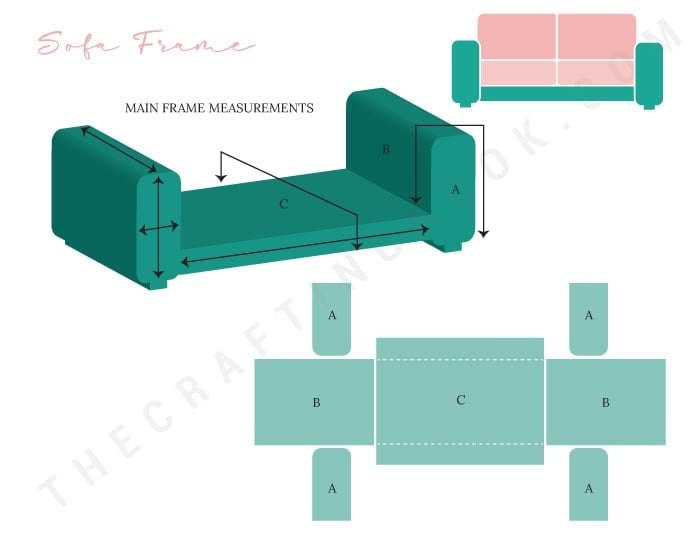
I started with the arms of the sofa.
As I mentioned above, to make sure the arm’s curves were as accurate as possible so tracing was the way to do it. So I definitely suggest you to trace the shape of curvy areas on a piece of paper.

I made sure I followed the right size and adjusted as necessary with the help of a ruler.
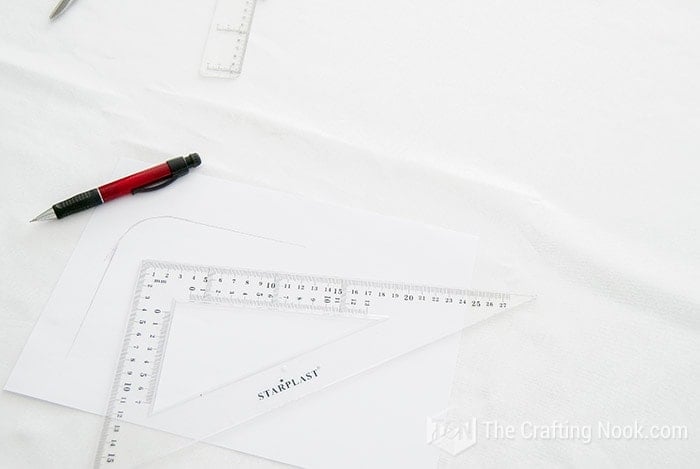
Folding the paper and cutting both sides at once helps to make sure both turn out exactly the same.
Then I proceeded to copy the pattern on the fabric and test it on the sofa to make sure everything was the way it should be.

As you can see on the frame pattern most pieces are rectangular so it was easy to set and cut.
Starting with the arms I sewed the front and back pieces to the main arm piece.
Tried it on the arm and once I confirmed it fit perfectly even in the crevices between the arms and backseat, so I repeated the same with the other sofa arm.

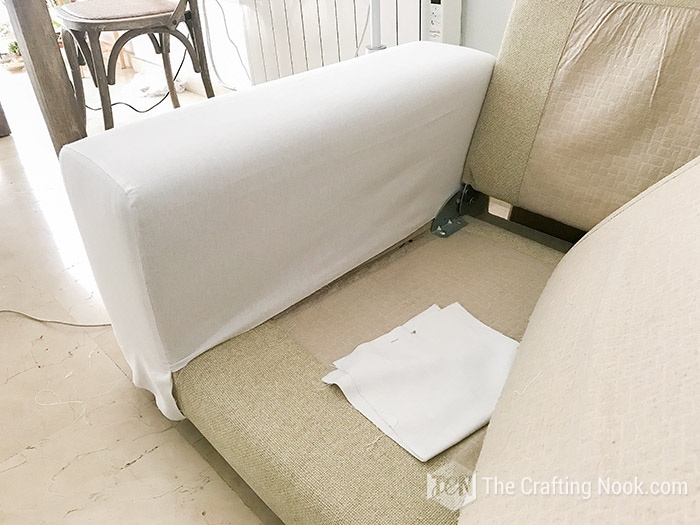
Removed both arm covers and pinned together (right sides together) the larger piece that goes along the base of the sofa main frame aligned the front piece of the arm.

As you can see, I have a hardware piece right next to the arm so I sewed both pieces until I hit that point and made a hem on the rest of the fabric.
In this case, since the back support is articulated and has an opening, I decided to make that piece of fabric go all the way to the back side so I can attach it to the back.
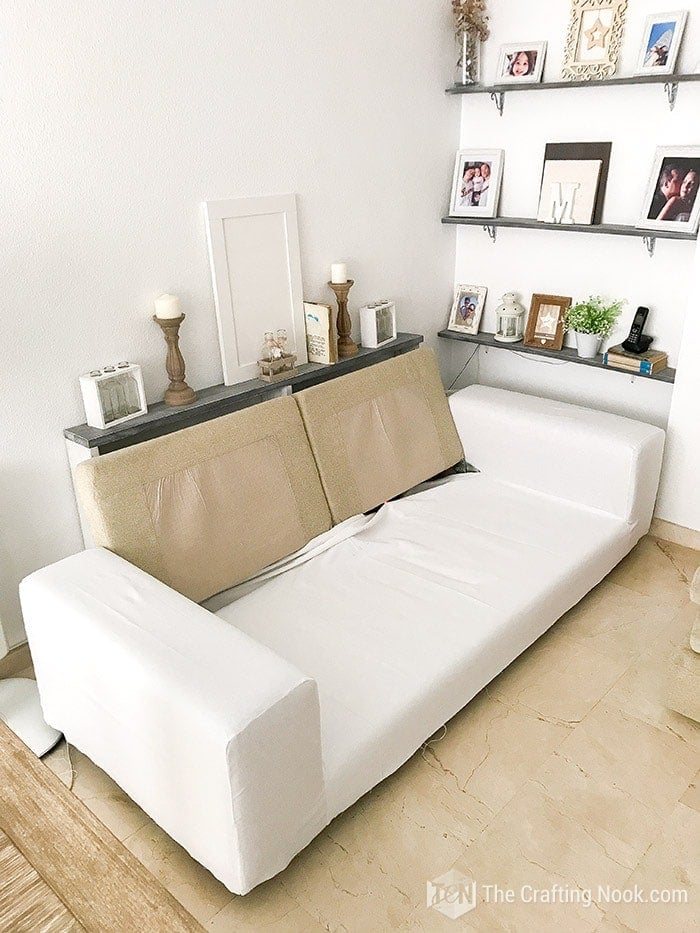
If your sofa doesn’t have that you would need to cut the fabric right where the original fabric seam is + 1cm (14″) for seam allowance.
Ok so, then I got the hardware right in the middle between the back and the base. Once the cover was in place, I folded the fabric, the wrong side up, and drew the guides to know where I have to create an opening.

I drew as follows:

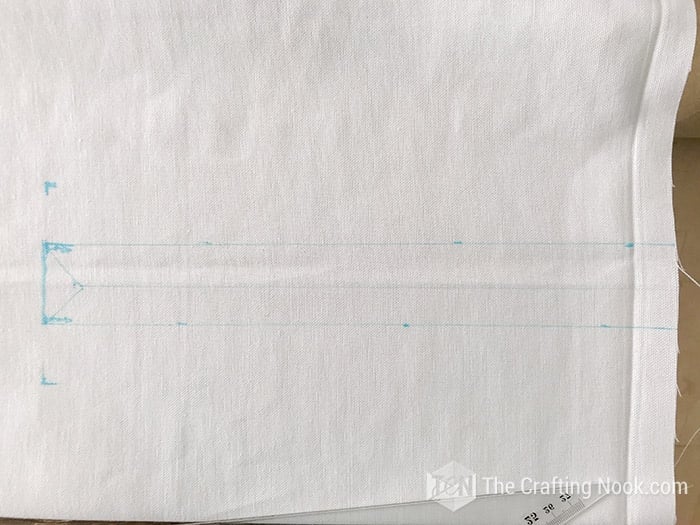
Cut along the internal lines and used it as the hem. It’s not the best finish but again none of this is going to be visible.

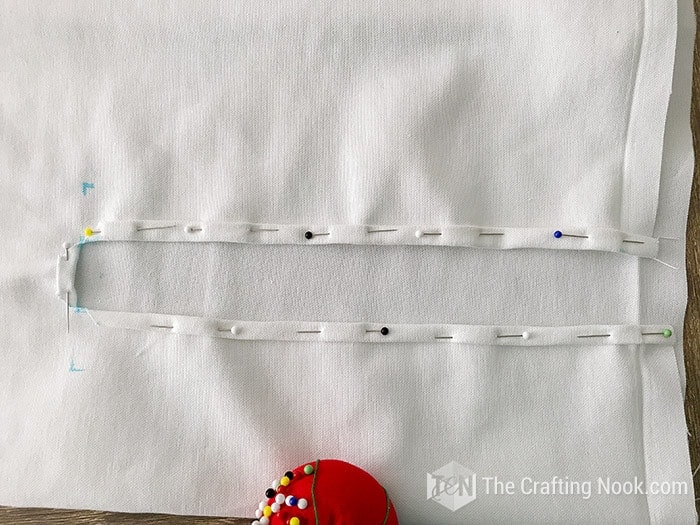
Since the whole cover was fitting perfectly, I zig-zagged all the raw edges and then reinforced and finished all the seams as I did with the cushions.
Then I sewed a piece of felt (about the same width as the seating cushion’s felt) along the base of the slipcover that would get in touch with the felt on the bottom of the seating cushion.
The last step was hemming the back pieces and install the velcro.

Lastly, it was time to create the back of the sofa support.
Step 9: Back of the sofa support
I cut 2 pieces like the pattern below.
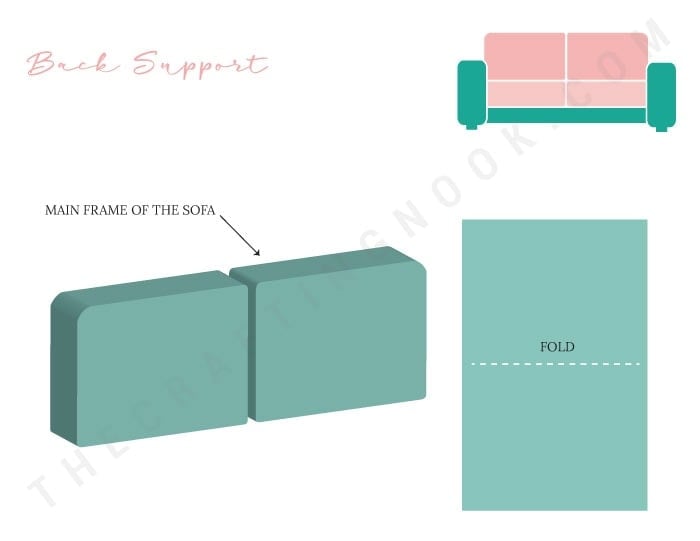
Folded each right side together and stitched both sides until it would meet the hardware. Hemmed the rest in a slight angle towards the center.

I zig-zagged raw edges.
I tried it on the sofa and with a pin, I marked the top corner of each side.
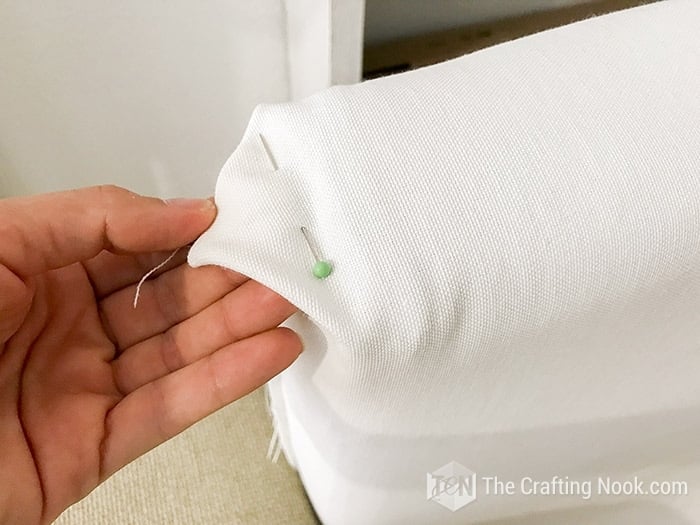
Then I stitched along the pin creating a triangle shape.
I turned it inside out and tried it again, and voila, it fit perfectly!

Then I made the hem on both ends and installed velcro to close it.

I did the same on the other back support.

Step 10: A final Touch
I wanted to make the final finish of the sofa cover very pretty so I decided to make a cute ruffle or should I call it pleats?

Placing the ruffles/pleats band and the cover bottom edge right sides together and starting from the back of one of the arms, I stitched all the way around the cover until the other arm.
As usual, I zig-zagged raw edges and finished it sewing over that seam very close to the edge on the right side of the cover.

It was time to put it all together!
¡Voila! The Sofa Slipcover is on and rocking!
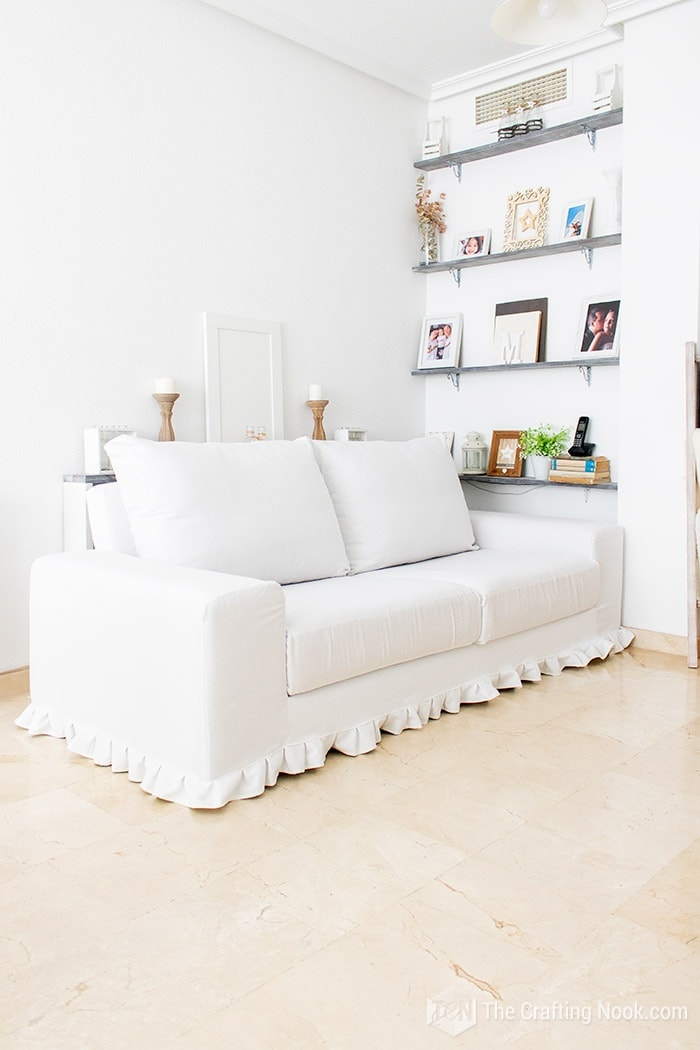
My sofa has a brand-new look! Now it looks gorgeous and like a brand new one!

I just LOOOVE it.

Now I can play with throw pillows, cushions, and blankets to match the season and holidays!
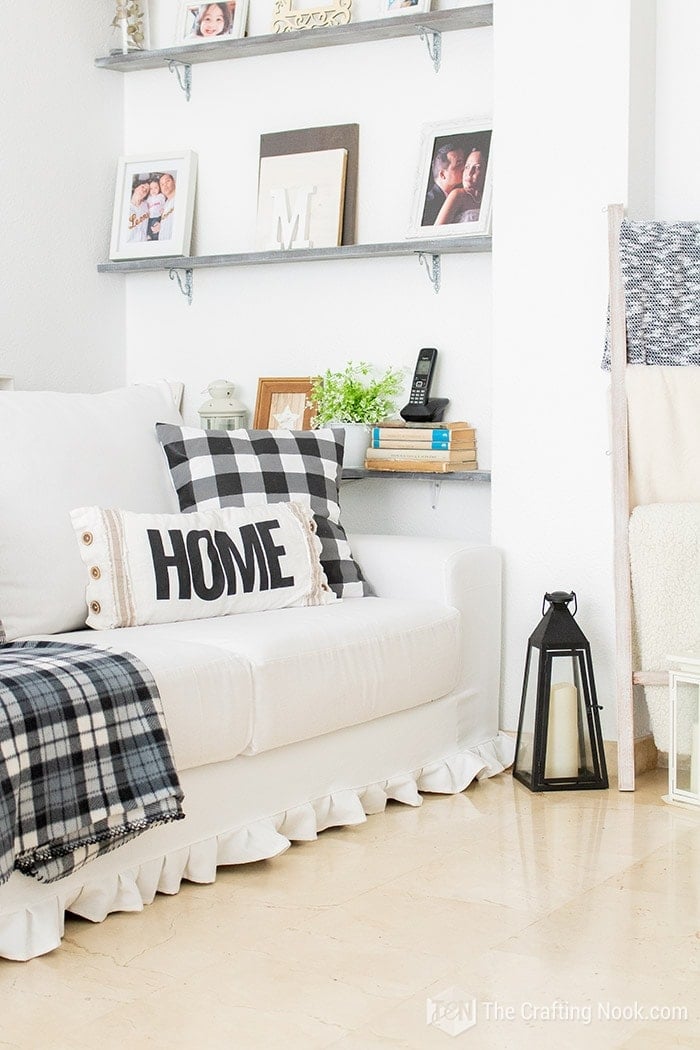
I’m so excited!
Frequently Asked Questions
That’s definitely a possibility. As just a cover I don’t like that it gets all wrinkled and off place every time anyone seats on it. However, I know Laurie from Tip Junkie has an interesting approach: Get some narrow cardboard tubes and wrap rubber bands around them. Push the tubes down into the couch’s crevices, and the bands will work to hold the sheets in place.
ok, here goes the “it depends”. It depends on your sofa shape and complexity, your sewing skills, although it doesn’t require being a professional sewer. And it depends on your level of patience LOL! Not being a professional sewer (not even close) I would say it’s not that hard. It does require time, patience, a bit of abstract thinking, and a lot of measurements. In this tutorial, I try my best to explain how you can approach your own sofa.
Well, my top choice is canvas, the stronger the better. I’ve heard from many bloggers that drop cloths work fine too. What you need to keep in mind before choosing your fabric is that it needs to be strong because when someone sits on the sofa, it creates an incredible amount of tension on the fibers and the first place it might tear up is on the seam. So for this type of couch slipcover, I don’t recommend using flat sheets or any similar type of fabric. Always go for furniture upholstering type of fabric.
More Sewing Projects to Try
If you found this Sofa Slipcover tutorial useful, you might love these other sewing project ideas too:
✂️ Tutorial

DIY Sofa slipcover Tutorial
Tools
- Sewing Machine
- scissors
- Pins
- Measurement tape
- Ruler
Supplies
- Canvas Fabric drop cloths work too but read that canvas is more durable
- Felt for anti-slip
- Thread
- Upholstery Zipper for the cushions
- Velcro
- Fabric Marker
Instructions
STEP 1: PREP WORK
- First, don’t make the mistake I made, and wash your fabric before starting. I completely forgot. With all the excitement and planning the video the measurements and all, I forgot to wash the fabric. Luckily, it didn’t shrink after I washed the covers, but it could have LOL.
- Getting measurements right was my biggest concern when I started this project. So, I definitely suggest measuring your sofa’s pieces really carefully and piece by piece. Sometimes it turns out that the front side might be larger or taller than the back side like it’s the case of my sofa’s seating cushions.
- When you pull the cushions, you see that both, the seating and back cushions are attached together with a zipper.
- I found it so clever that I decided to do the same on the new covers.
- The seat cushion is a lot less fluffy and straightened so it was easier to measure each piece with the cover on.
- The Back cushion was easier measuring the cover alone straightened on the table.
- Then the sofa had an anti-slip fabric that prevents the cushions from moving towards the front of the sofa.
- I decided to keep that but using felt. It did the trick!
STEP 2: SOFA MEASUREMENTS
- The first step in creating a custom cushion cover is to use your measuring tape to measure the cushion length, width, and height: I measured well top, bottom, and each side independently.
- I took notes of each measure and then double-checked (call me paranoid)
- general view of the room with the sofa and me writing down measurements
- Add about 2 cm (1/2″) to each measurement. This will allow for a 1 cm (1/4″) seam allowance on all sides and create a nice snug cushion cover.
- I used the original cushion as a guide for where my zipper should start and end.
- Then with the frame, I did the same. I measured each piece separately.
STEP 3: CREATE YOUR CUSHION PLAN
- The next thing I did was create rough graphics of each piece with measurements to have a better idea of the piece I have to create.
- It’s easier to have them on paper than having the huge cushions on the table LOL.
- I didn’t want to do it like I saw most people doing it. Like throwing the fabric on top of the main frame of the sofa and then giving shape and securing with pins although it worked for them.
- I thought that because this sofa was geometric enough for me to create the pattern based on measurements and I’m glad I did because it worked perfectly.
STEP 4: CREATING THE MAIN FRAME PATTERN
- Since the sofa arms’ corners are rounded, to get the exact curve I drew its shape on a piece of paper.
- Then I folded the paper and cut so both curves would be exactly the same.
STEP 5: CREATING THE SOFA CUSHION PATTERNS
- So, I started with the cushions. Gladly, since I have 2 sets, I experimented with one before actually recording and taking pictures to make sure it worked.
- I’m glad I did because I found out the hard way that the front side of the seating cushion was taller than the back UGH. Thankfully I could fix it instead of making it all over again and wasting fabric.
- So, you will need to cut five pieces for each cushion: a top, a bottom, a piece for the back side where the zipper goes, a piece for the rest of the band around the middle AND a piece for the anti-slip piece (this last one is optional so I didn’t put it in the graphic).
- *I didn’t add the cushion’s attachment in the graphics above either since are optional as well, but I’m explaining how to add it in case you like the idea.
- I decided to make the front and both sides, one piece to make it look prettier but you can go for the separate pieces and sew them together if you prefer.
- Optimizing the fabric (or any material for that matter) as much as I can is one of my top goals in this kind of project. so with the fabric folded (as it comes from the store) I measured the width, and based on that I calculated what pieces I could fit to I would waste the least.
STEP 6: BUILDING THE BACK CUSHION
- I took my back cushion pieces and got the back and the felt pieces.
- Fold them both widthwise and made a mark at the edge of the folding. This is to match centers.
- Pin both places together with top edges aligned.
- Stitch around the felt.
- Then if like me, you are making white covers, you will inevitably wash them a lot.
- Adding a zipper will make your cushion covers so much easier to remove and put back on. And adding a zipper really is easier than you think!
- I used cut-to-size upholstery zippers. You can find them in package and depending on where you live you might be able to buy them by yards, so I was able to get zippers for for all 4 cushions.
- I also bought 2 jacket-kind zippers because you can detach them. This will be for the cushion’s attachment. This step is totally optional. I found it very useful so went through the trouble of putting it.
- Since I used the original cushion as a guide for where my zipper should start and end, I cut the zippers the exact size as the original covers zippers.
- I folded one edge over of the the bottom piece and the back piece of the cushion and pinned to the zipper. It helps to iron the first small fold first.
- Since the zipper is shorter than the cushion I made sure it was centered making center marks as I did with the felt.
- To add the attachment zipper like the original, I placed one of the pieces of the jacket zipper on top of the other zipper as centered as possible and slightly overlapping it. I used center marks as well.
- So, it goes layered like this: Main zipper, jacket zipper, then back side piece of fabric (edge folded).
- Pinned everything in place
- Then I sewed the fabric to the zipper using my zipper foot.
- Honestly, I didn’t see the need to try to hide the zipper since it will be at the back, and it’s not gonna be visible.
- Since the zipper is shorter than the cushion’s width, I stitched the bottom piece and the side together as close as the sipper as possible until the end of the piece.
- There you go, the zipper is installed.
- Then I pinned the bottom piece with the zipper to the rest of the band (right sides together) that will go around the center.
- Next, I pinned the back piece with the zipper to both ends of the band.
- I sewed the pieces together.
- The last step for this cushion was the top piece.
- I opened the zipper slightly so I could turn it inside out later and pinned the top piece to the back side and the side band. If all the measurements were ok, it should fit perfectly. And it did.
- Sewed the pieces together and turned them inside out.
- The cushion cover was ready to go!
- Once I confirmed everything fit perfectly I went for the finishes.
- I zig-zagged all the raw edges.
- And then sewed over that seam very close to the edge on the right side of the cover to reinforce and create a prettier finish.
- That was it.
STEP 7: BUILDING SEAT CUSHION.
- The system was basically the same as the back cushion. The only difference was adding the attachment strip of fabric with zipper and the main zipper would go along to the sides of the cushion.
- You can either do it as I did or modify the back piece following Christy’s Cushion tutorial which is great. In my case, I replicated the original cushion to the minimum detail LOL.
- To create the attachment piece, I worked next to the original cushion to make sure I would install the zipper in the right place in the right position.
- Making center marks, the attachment piece could be positioned exactly as it was on the original cushion
- I zig-zagged the edges, then folded the fabric edge that goes on the zipper and stitched the zipper and hem on both short sides.
- Next, I pinned the zipper in place. In this case back side and the attachment piece, both need to be right side up.
- Pinned in place and tested that the back cushion would indeed attach perfectly. Stitched in place.
- Then I followed the same steps from the back cushion.
- To install the Zipper I just pinned the zipper as before but this time I followed the curve to on both corners to the sides and stitched. Here again, I didn’t bother to hide the zipper because it will not be visible.
- The rest follows the exact same steps as the back cushion.
- Of course, I repeated the process with the other set of cushions. When done they would look something like this:
STEP 8: THE MAIN FRAME SLIPCOVER.
- I started with the arms of the sofa.
- As I mentioned above, to make sure the arm’s curves were as accurate as possible so tracing was the way to do it. So I definitely suggest you to trace the shape of curvy areas on a piece of paper.
- I made sure I followed the right size and adjusted as necessary with the help of a ruler.
- Folding the paper and cutting both sides at once helps to make sure both turn out exactly the same.
- Then I proceeded to copy the pattern on the fabric and test it on the sofa to make sure everything was the way it should be.
- As you can see on the frame pattern most pieces are rectangular so it was easy to set and cut.
- Starting with the arms I sewed the front and back pieces to the main arm piece.
- Tried it on the arm and once I confirmed it fit perfectly even in the crevices between the arms and backseat, so I repeated the same with the other sofa arm.
- Removed both arm covers and pinned together (right sides together) the larger piece that goes along the base of the sofa main frame aligned the front piece of the arm.
- As you can see, I have a hardware piece right next to the arm so I sewed both pieces until I hit that point and made a hem on the rest of the fabric.
- In this case, since the back support is articulated and has an opening, I decided to make that piece of fabric go all the way to the back side so I can attach it to the back.
- If your sofa doesn’t have that you would need to cut the fabric right where the original fabric seam is + 1cm (14″) for seam allowance.
- Ok so, then I got the hardware right in the middle between the back and the base. Once the cover was in place, I folded the fabric, the wrong side up, and drew the guides to know where I have to create an opening.
- Cut along the internal lines and used it as the hem. It’s not the best finish but again none of this is going to be visible.
- Since the whole cover was fitting perfectly, I zig-zagged all the raw edges and then reinforced and finished all the seams as I did with the cushions.
- Then I sewed a piece of felt (about the same width as the seating cushion’s felt) along the base of the slipcover that would get in touch with the felt on the bottom of the seating cushion.
- The last step was hemming the back pieces and install the velcro.
- Lastly, it was time to create the back of the sofa support.
STEP 9: BACK OF THE SOFA SUPPORT
- I cut 2 pieces like the pattern below.
- Folded each right side together and stitched both sides until it would meet the hardware. Hemmed the rest in a slight angle towards the center.
- I zig-zagged raw edges.
- I tried it on the sofa and with a pin, I marked the top corner of each side.
- Then I stitched along the pin creating a triangle shape.
- I turned it inside out and tried it again, and voila, it fit perfectly!
- Then I made the hem on both ends and installed velcro to close it.
- I did the same on the other back support.
STEP 10: A FINAL TOUCH
- I wanted to make the final finish of the sofa cover very pretty so I decided to make a cute ruffle or should I call it pleats?
- Placing the ruffles/pleats band and the cover bottom edge right sides together and starting from the back of one of the arms, I stitched all the way around the cover until the other arm.
- As usual, I zig-zagged raw edges and finished it sewing over that seam very close to the edge on the right side of the cover.
- It was time to put it all together!
- ¡Voila! The Sofa Slipcover is on and rocking!
Share and PIN ME!!!!

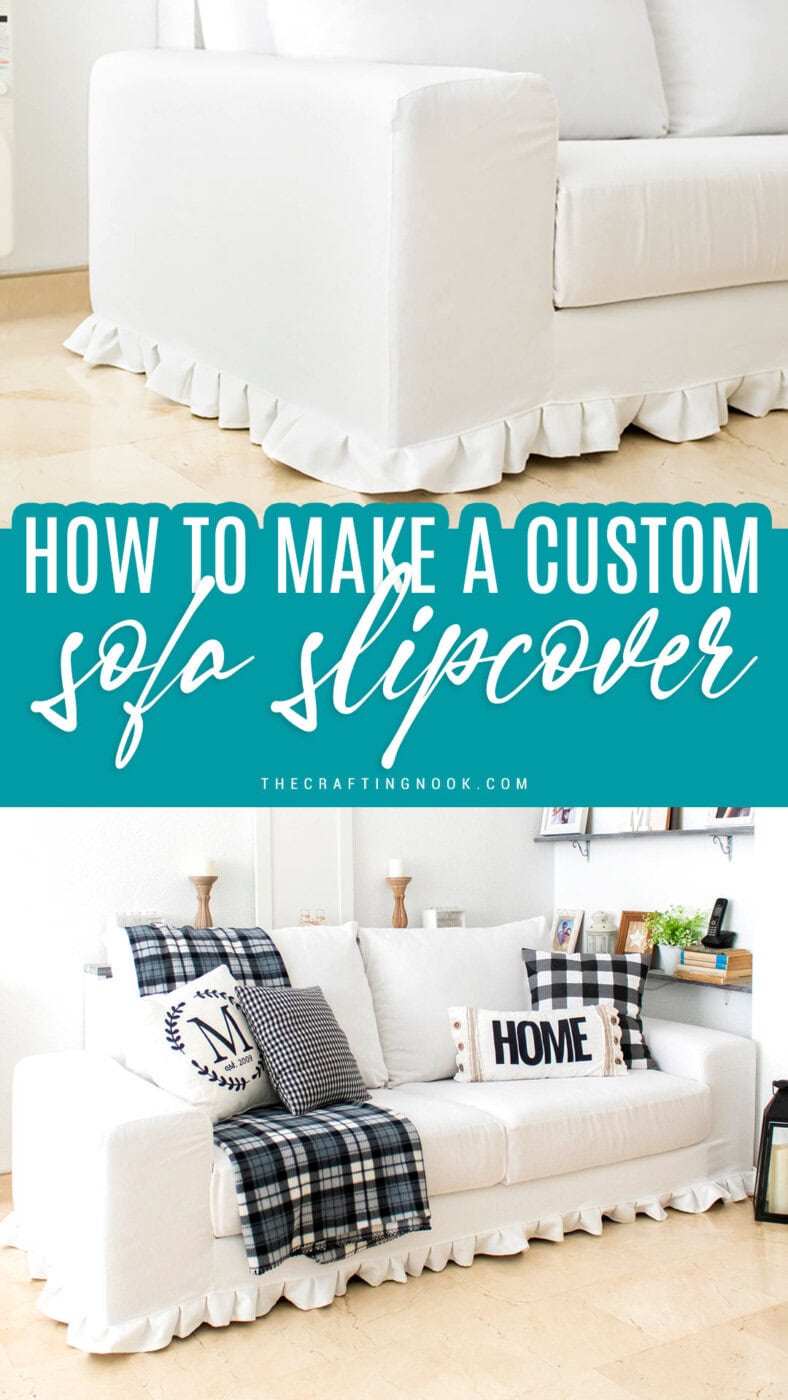
Til’ next time…

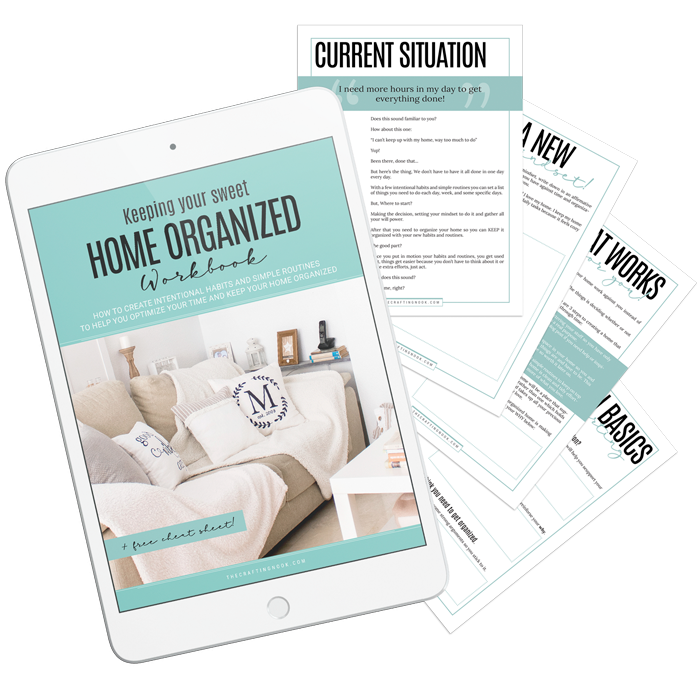
FREE WORKBOOK
Keeping your Sweet Home Organized
Learn how to create intentional habits and simple routines to Keep Your Home Organized. Plus freebies, printables, exclusive content, and tips.
Disclaimer: By clicking on the “Yes” button above you are giving me your consent to collect and use your information according to the law and My Policy Privacy. Zero Spam I promise!

